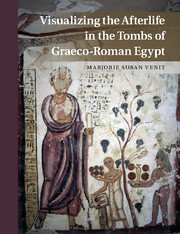Book contents
- Visualizing the Afterlife in the Tombs of Graeco-Roman Egypt
- Visualizing the Afterlife in the Tombs of Graeco-Roman Egypt
- Copyright page
- Dedication
- Contents
- List of Illustrations
- Book part
- Map
- Introduction
- One Death, Bilingualism, and Biography in the ‘Eventide’ of Egypt
- Two Egypt as Metaphor
- Three Greek Myth as Metaphor in the Chora of Egypt
- Four Tradition and Innovation in the Tombs of the Egyptian Chora
- Five Bricolage and Greek-Collage in the Tombs of the Egyptian Chora
- Six Intersection and Interconnection in the Visualization of the Afterlife in Tombs of Graeco-Roman Egypt
- Notes
- Bibliography of Modern Works Cited
- Index
- Plate Section
- References
Bibliography of Modern Works Cited
Published online by Cambridge University Press: 05 November 2015
- Visualizing the Afterlife in the Tombs of Graeco-Roman Egypt
- Visualizing the Afterlife in the Tombs of Graeco-Roman Egypt
- Copyright page
- Dedication
- Contents
- List of Illustrations
- Book part
- Map
- Introduction
- One Death, Bilingualism, and Biography in the ‘Eventide’ of Egypt
- Two Egypt as Metaphor
- Three Greek Myth as Metaphor in the Chora of Egypt
- Four Tradition and Innovation in the Tombs of the Egyptian Chora
- Five Bricolage and Greek-Collage in the Tombs of the Egyptian Chora
- Six Intersection and Interconnection in the Visualization of the Afterlife in Tombs of Graeco-Roman Egypt
- Notes
- Bibliography of Modern Works Cited
- Index
- Plate Section
- References
- Type
- Chapter
- Information
- Visualizing the Afterlife in the Tombs of Graeco-Roman Egypt , pp. 239 - 254Publisher: Cambridge University PressPrint publication year: 2015



